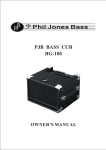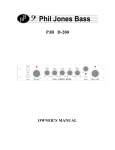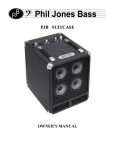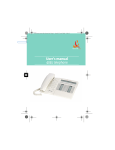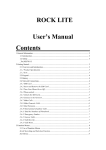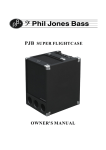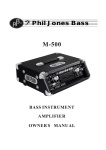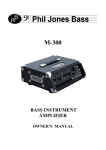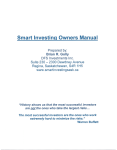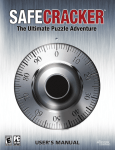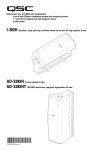Download OWNERS MANUAL
Transcript
6T - 8T- 9B - 16B - 24B LOUDSPEAKER ENCLOSURES OWNER’S MANUAL Thank you for purchasing PJB Piranha Speakers. A great deal of dedication and passion went into designing and building this no-compromise, high performance loudspeaker system. These are dedicated loudspeakers for the “demanding” bassist. Reading this manual will enable you to get the best performance from them and it will give you many years of service. READ THIS FIRST • • • • • • • • • • Before using the Piranha Speakers please read ALL the instructions. On receipt of product, check for any signs of physical damage arising from shipping. If any damage is visible contact your dealer. Keep all original packing. Never use this product in the vicinity of water. Never connect more than one amplifier to a speaker! The acoustic output of this loudspeaker can generate enough sound pressure levels to cause PERMANENT hearing damage to you and anyone else who is close to it. Take caution with how much volume is used. If you suffer from ears ringing, this is an indication that you may be damaging your hearing. Do not locate this speaker near any heat source. This speaker must be connected to an amplifier as specified in this manual. Do not let any liquid or foreign objects fall into any openings of the speaker. Do not use this speaker if it has: 1. Suffered by considerable physical damage. 2. Been subjected to any liquids, rain or moisture. 3. Damaged cables connected to it. INTRODUCTION PJB loudspeakers are a radically different approach to dedicated bass instrument speakers not only in design philosophy but also in performance and build quality. Fully understanding our speakers will enable you to get the best out of your playing ability and sound. On the surface the PJB cabinet may look somewhat of a gimmick to some. However, behind this unique appearance is a very solid scientific foundation. At the heart of your speaker cabinet is a specifically designed bass instrument transducer, a tiny 5” driver in comparison to what is considered normal size bass reproducer. There has been a misperception that bigger drivers are better for bass loudspeakers. The performance of PJB speakers can prove to you small drivers can be just as powerful and more agile in response than big drivers. For more information of our technology, we strongly suggest you to visit the “tech info” section of our website. Many music instrument amplifier manufacturers simply stuff boxes with marketable driver configurations with little or no regard to the science of electro-acoustics. As a result bass, players have had to compensate for the inadequacies of these speaker systems with effects, EQ, limiters and even their playing techniques. Now for the first time, bass players can be liberated with the totally radical new concept amplification from PJB. 1 PJB speakers will only perform at their best if they are used with other PJB speakers. We recommend that you do not use them with any other brand name speakers. If you do, your overall sound quality will be greatly impaired, as the other speakers will not be working as precisely in the same time or frequency domain as PJB speakers. A comparable example is that you would not want to have a mixture of different tires on your car, since road holding would be impaired. PJB speakers have been calculated using the latest computer aided design software to enable them to work at the absolute optimum electroacoustic performance in various combinations. Like your instrument, you will only get the best from your speakers if they are set up correctly. Setting up your speakers Ideally you should be connecting up your speakers to PJB amplifiers because these are designed to match perfectly together. Before turning on any power, connect up your speakers to the amplifier. Keep the speaker cables as short as possible. We recommend the PJB speaker cables. Only Speakon connectors are used on all our cabinets and amplifiers because they are simply better suited for high current applications than ¼ inch jacks. The 9B, 16B and 24B enclosures can be used singularly but there will be a great sonic improvement if you combine these cabinets with the 6T or 8T. The 6T is designed for use with 9B .The 8T will work with 16B or 24B. This is because these configurations allow exactly the same power across each speaker. Using a 6T on top of a 16B will work but the drivers in the 6T will individually receive more power than the drivers in the 16B, consequently limiting headroom of the system. Please refer to the diagram of “Possible Speaker Configuration” on page 8 for alternative configurations. CAUTION! Take great care in stacking speakers. Make sure locked wheels and rubber feet are sitting correctly in the cabinet recesses. Taller configuration stacks will have higher centers of gravity and therefore less stability. DO NOT try to move speakers and amps stacked on each other. A large loudspeaker enclosure falling could cause you or others serious injury. Take the greatest of care when transporting your rig. Speakers should be rolled on casters individually and not stacked when doing so. Do not take any unnecessary short cuts that you may regret! ALWAYS LOCK FRONT WHEELS LIKE THIS ON THE GROUND SPEAKER. THIS WILL GREATLY IMPROVE STABILITY WHEN STACKING CABINETS. 2 Matching Speakers to amplifiers. Many amplifier companies specify using 4 or 8Ω speakers. In reality, there is not such thing as a speaker with these constant impedance ratings. Typically 4 or 8Ω ratings are what are referred to as the minimum impedance and that will determine what is a safe load for your amplifier. It is easily possible for an 8Ω speaker to vary from 8 to 40Ω or more. Some speakers that are rated at 8Ω may have a lower actual rating than 8Ω. PJB speakers are rated at their minimum impedance point. That makes them an easy load for just about any amplifier. Just about any amplifier that can run down to 4Ω or even 2Ω can handle any impedance from a high 32Ω down to 4 or 2Ω any anything in between. So if you have a 5.3Ω load, it will not bother your amp at all. It may be even perform better on this than a 4Ω load. It depends on your amp. PJB amps will handle any of the speaker combinations laid out in this manual with ease. Cables High quality bass amplification demands low-loss, high current speaker cables. Using cables that is not specifically designed for this application will result in significant degradation of your speaker’s performance. PJB cables are ultra-low resistance with high current capability, improving your speaker’s definition and control. We recommend for best results that you use PJB speaker cables since they are matched to the performance of these speakers PJB SPEAKER CABLES Impedance & Phase Response of PJB Speaker Cables versus Leading Brand’s Equivalent 3 Connecting up your speakers All PJB speakers feature genuine Neutrik NL4MP SPEAKON, airtight loudspeaker sockets featuring low resistance silver contacts. These have a current rating of 40 amps making them the ideal bass instrument speaker connection. Using both the 2 positive and 2 negative connections in parallel results in each PJB speaker connection capable of handling peaks of up to 80 amps! The two Speakons on the rear recess plate allow parallel-connected speakers to your amplifier. Just plug your amplifier into the input socket and then connect your other speaker to the link out socket. If you are using two speakers connected to your amplifier a better way of connection is to use each speaker directly connected to your amp’s output-sockets. This will give a lower cable resistance (due to the speaker cables also running in parallel) improving your sound. How to calculate the total impedance of multiple Piranha speakers Count number of speakers across and multiply by 8 (example 4 across = 32) Divide this number (example 32) by number of rows down. (Example 8) = 4 Ohm Load. DO NOT CONNECT CABINETS TOGETHER THAT HAVE A DIFFERENT NUMBER OF DRIVERS ACROSS. (EXAMPLE: A 6T ON TOP OF A 16B This will put more power through the top cabinet, making it work harder and will limit your total power handling.) A Note on Amplifier Power and Speaker Power Handling Very often loudspeakers and amplifier power ratings are totally misunderstood by the non-technical user for good reason. This is a complex and involving topic that will only be touched upon lightly in this manual. First the ear is not capable of telling how much power is going to a loudspeaker. Secondly ALL loudspeakers have different power ratings at each and every frequency. The amplifier will produce different power levels if the frequency changes, even if the volume is the same. Finally, we hear sound based on a logarithmic scale. So in order to perceive a note twice as loud, in theory we need 10 times the power to produce the perceived doubling of volume. In reality another parameter comes into this already complex equation. It’s called “Power Compression” which is the losses in the loudspeaker units due to heating up and reducing efficiency of converting the amplifier’s electrical power to acoustic energy. Loudspeakers are complex devices and very inefficient converters of electrical energy especially when it comes to reproducing bass frequencies. More than 90% of amp power goes to heating up the speakers and that is why the “Power Compression” factor is a major one. It is physically impossible to create a loudspeaker that is 100% efficient or even close. For bass instruments even 20% efficiency is almost impossible unless you are a billionaire! Two limiting factors determine the power handling of a bass speaker. One is the ability to withstand the heat buildup before the unit goes up on smoke. The other is the excursion capability of the cone. The cone will move in and out further not only with volume increase but also as you play lower notes. An open B or E string will cause the cone to move more than an open G-string at the same volume level. Also boosting the bass EQ on your amplifier’s tone controls will cause greater excursion on the speaker cones. 4 PJB bass instrument speakers were developed with a focus to overcome the problem of power compression, and this is one of the reasons they outperform competitive products both in sound quality and power handling. Warranty Information PJB speakers have a warranty period of 2 years, starting from the date of purchase. The buyer must complete and return the enclosed warranty card within 14 days of purchase. This warranty covers defect in materials or workmanship that occurs in normal use. Within warranty period PJB will repair or replace the defect unit free of labor and parts charge. It is the buyer’s responsibility to use the speakers strictly according to instructions written in this manual. This warranty is not transferable; it is provided to original owner only. Damage/defects caused by the following conditions are not covered by this warranty: Improper handling, neglect or failure to operate the unit in compliance with the instructions given in user manual; Connection or operation of the speakers in any way that does not comply with the technical or safely regulations applicable in the country where the product is used; Repairs or modifications by anyone other than authorized PJB service agent; Damages/defects caused by force majeure or any other condition that is beyond the control of PJB. Should you need any warranty service, please bring the speaker back to the dealer from whom you purchased the amplifier, along with your sales receipt. Depending on the complexity of the repair work, your dealer may return the defect unit to PJB service center for repair or replacement. Phil Jones Bass 8559 Page Ave St. Louis, MO 63114. USA Tel: 314 814 1264 Fax: 314 628 9941 www.philjonesbass.com [email protected] Serial Number: ______________________ Date Purchased: _____________________ Dealer: _______ _____________________ All PJB owners manuals can be downloaded form our website www.philjonesbass.com in PDF files. 5 LOUDSEAKER SPECIFICATIONS Piranha Cabinet Systems Minimum Impedance Ohms 6T 8T 9B 16B 24B 12 16 8.0 8.0 5.3 Maximum dB at 10 feet with Rec. Amp 111dB 115dB 117dB 120dB 127dB 6T&9B 4.8 119dB 8T&16B 5.3 127dB 8T&24B 4.0 128dB Equivalent Conventional Cabinet/Cone area 1 x 12” 2 x 10” 1 x 15” 4 x 10” 6 x 10” or 4 x 12” 1 x 15” & 1x12” 6 x 10” or 4 x 12” 8x10” or 4 x 15” 6 Frequency Range Maximum Power Handling Dimensions HxWxD (mm) Net weight Per speaker 50Hz – 15kHz 45Hz – 15kHz 40Hz – 15kHz 30Hz – 15kHz 25Hz – 15kHz 600W 800W 900W 1600W 2400W 330x520x445 395x625x495 458x520x445 700x625x495 965x625x495 24 Kg 33 Kg 36 Kg 58Kg 78 Kg 35Hz – 15kHz 1500W - - 27Hz – 15kHz 2400W - - 23Hz – 15kHz 3200W - - 7 POSSIBLE SPEAKER CONFIGURATIONS PER AMPLIFIER P A SS V I E Hz +4 OFF L EV E L Hz L EV E L Hz L EV E L GRA P HIC 500 P A RA MET RI C dB 0 5 25 2 00 6 4 3 0 Hz V OLUME I NPUT 11 L EV E L Hz L EV E L 500 P A RA MET RI C 0 ON 5 30 3 0 Hz 4 0 Hz -1 5dB 6 0 Hz + 15 dB 3 00 1 0 0H z 1 8 0H z 2K -1 5dB + 15 dB 3 4 0H z 6 6 0H z 1 .3k Hz 3K 2 .6k Hz 1 5K 5 kHz -1 5dB + 15 dB 5 V OLUME I NPUT 6 2K -1 5dB + 15 dB 3 4 0H z 6 6 0H z 1 .3k Hz 3K 2 .6k Hz 1 5K 5 kHz -1 5dB 1 0 kH z 250 + 15 dB 5 6 7 3 1 5 kH z 6 6 + 8 H EADP HON E O UTPUT O FF 9 1 10 0 P OWER O UTPUT FX S END ON V OL UME PEDAL FX R ETURN H EADP HON E O UTPUT 7 3 1 0 kH z 1 5 kH z 9 10 0 8 6 + 0 6 6 O FF 9 2 +6 0 - L INE N I 3 00 1 8 0H z 0 6 250 4 8 2 1 M AX 0 C OM PR ESS ION 2 00 7 3 L IMI T E R 25 6 4 B A SS 1 0 0H z 0 0 M AX C OM PR ESS ION P OWER WATTS -2 5 A CTI V E 6 0 Hz 2 +6 - Hz 4 0 Hz 9 10 0 L EV E L + 15 dB 4 8 2 1 Hz GRA P HIC dB -1 5dB 7 3 L IMI T E R +4 OFF P OWER WATTS -2 5 ON B A SS A CTI V E L INE N I P A SS V I E 10 1 0 P OWER O UTPUT FX S END ON V OL UME PEDAL FX R ETURN P A SS V I E +4 Hz GRA P HIC OFF L EV E L Hz L EV E L Hz L EV E L 500 P A RA MET RI C dB 0 5 25 30 6 4 3 0 Hz V OLUME I NPUT L EV E L Hz L EV E L 500 P A RA MET RI C Hz +4 OFF L EV E L Hz L EV E L Hz L EV E L 500 P A RA MET RI C GRA P HIC dB 0 5 4 3 0 Hz 2 00 -1 5dB + 15 dB 3 00 2K -1 5dB + 15 dB 3K 1 5K -1 5dB M AX 0 C OM PR ESS ION 6 0 Hz + 15 dB 3 00 1 0 0H z 1 8 0H z 2K -1 5dB + 15 dB 3 4 0H z 6 6 0H z 1 .3k Hz 3K 2 .6k Hz 1 5K 5 kHz -1 5dB 1 0 kH z 3 00 1 0 0H z 1 8 0H z 2K -1 5dB + 15 dB 3 4 0H z 6 6 0H z 1 .3k Hz 3K 2 .6k Hz 1 5K 5 kHz -1 5dB 1 0 kH z 5 4 8 3 0 Hz 4 0 Hz 6 0 Hz 1 0 0H z 1 8 0H z 3 4 0H z 6 6 0H z 1 .3k Hz 2 .6k Hz 5 kHz 6 6 5 6 8 0 + 8 6 0 0 6 6 0 P OWER O UTPUT FX S END 6 0 P OWER O UTPUT V OL UME PEDAL FX R ETURN ON SIX-PAK 9B 4.8-OHMS SIX-PAK 12B 4-OHMS 9B 8-OHMS 12B POSITION 1 6-OHMS +4 Hz GRA P HIC OFF L EV E L Hz L EV E L Hz L EV E L 500 P A RA MET RI C dB 0 5 25 30 6 3 0 Hz V OLUME I NPUT 11 P A SS V I E Hz +4 L EV E L Hz L EV E L L EV E L Hz GRA P HIC OFF 500 P A RA MET RI C dB 0 5 L EV E L Hz L EV E L 500 P A RA MET RI C 3 0 Hz +4 GRA P HIC L EV E L Hz L EV E L Hz L EV E L 500 P A RA MET RI C dB 0 5 6 0 Hz + 15 dB 1 0 0H z 3 00 2K 1 8 0H z 3 4 0H z +6 -1 5dB + 15 dB 6 6 0H z 1 .3k Hz 3K 2 .6k Hz 1 5K 5 kHz -1 5dB 1 0 kH z 5 11 6 + 4 0 Hz 6 0 Hz + 15 dB 1 0 0H z 3 00 2K 1 8 0H z 3 4 0H z -1 5dB + 15 dB 6 6 0H z 1 .3k Hz 3K 2 .6k Hz 1 5K 5 kHz -1 5dB 1 0 kH z 2K -1 5dB + 15 dB 6 6 0H z 1 .3k Hz 3K 2 .6k Hz 1 5K 5 kHz -1 5dB 250 + 15 dB 5 6 7 3 1 0 kH z 1 5 kH z 6 6 + H EADP HON E O UTPUT 8 O FF 9 1 0 P OWER O UTPUT 11 FX S END ON V OL UME PEDAL FX R ETURN 250 + 15 dB 5 6 7 3 1 5 kH z H EADP HON E O UTPUT 8 6 0 + 0 6 6 O FF 9 2 +6 - 6 7 3 6 0 6 3 00 1 8 0H z 3 4 0H z 10 1 0 P OWER O UTPUT 11 FX S END ON - 250 + 15 dB 1 5 kH z 0 1 0 0H z 0 6 L INE IN H EADP HON E O UTPUT 8 M AX 0 C OM PR ESS ION V OL UME PEDAL FX R ETURN O FF 9 10 1 0 P OWER O UTPUT 11 FX S END ON V OL UME PEDAL FX R ETURN P OWER WATTS -2 5 6 25 30 3 2 00 -1 5dB + 15 dB 3 00 2K -1 5dB + 15 dB 3K 1 5K -1 5dB 4 0 Hz 6 0 Hz 1 0 0H z 1 8 0H z 3 4 0H z 6 6 0H z 1 .3k Hz 2 .6k Hz 5 kHz 1 0 kH z 1 5 kH z 6 7 3 9 10 V OLUME I NPUT 5 4 3 0 Hz 8 2 1 250 + 15 dB 7 B A SS 0 4 0 Hz 2 11 - Hz -1 5dB 4 89 V OLUME I NPUT 3 0 Hz 9 V OLUME I NPUT P OWER WATTS 2 00 7 0 -1 5dB 4 8 0 Hz 25 30 6 1 2 00 7 2 1 L EV E L 0 5 4 3 2 + 15 dB 0 P OWER 25 30 6 4 3 LM I IT ER Hz GRA P HIC dB -2 5 ON LM I IT ER M AX 0 C OM PR ESS ION M AX 0 C OM PR ESS ION WATTS -2 5 ON B A SS A CTI V E +4 OFF B A SS 6 0 Hz 2 +6 - A CTI V E 4 0 Hz 9 0 P A SS V I E -1 5dB 4 8 2 1 L INE IN 2 00 7 4 3 L IMI T E R P OWER WATTS -2 5 ON B A SS 4 ON FX R ETURN A CTI V E OFF O FF FX S END FX R ETURN O FF FX S END P A SS V I E ON H EADP HON E O UTPUT 9 V OL UME PEDAL 11 V OL UME PEDAL L INE N I L IMI T E R 8 10 P OWER O UTPUT - - SIX-PAK 12-OHMS 6 6 6 6 0 + 0 H EADP HON E O UTPUT 8 2 + - M AX 0 C OM PR ESS ION 7 0 0 ON 1 + 0 6 M AX 0 C OM PR ESS ION P A SS V I E 6 1 + 6 O FF 9 10 1 9 2 +6 V OLUME I NPUT - L INE N I 5 3 2 6 H EADP HON E O UTPUT 7 3 6 H EADP HON E O UTPUT 7 3 1 0 kH z 1 5 kH z 9 1 A CTI V E 250 + 15 dB 1 5 kH z 6 250 + 15 dB 1 5 kH z 2 + 250 + 15 dB 7 2 0 4 0 Hz 9 P OWER 25 30 6 3 L IMI T E R -1 5dB 4 8 10 WATTS -2 5 ON B A SS 2 00 7 V OLUME I NPUT L INE IN P A SS V I E L INE N I + 15 dB 0 M AX 0 C OM PR ESS ION P OWER WATTS 25 30 6 1 A CTI V E 6 0 Hz +6 11 - Hz 4 0 Hz 9 10 0 L EV E L 0 5 4 3 2 0 -1 5dB 4 8 2 1 Hz GRA P HIC dB -2 5 ON LM I IT ER 2 00 7 3 LM I IT ER +4 OFF B A SS A CTI V E P OWER WATTS -2 5 ON B A SS A CTI V E L INE IN P A SS V I E O FF 9 1 0 P OWER O UTPUT FX S END ON V OL UME PEDAL FX R ETURN 6T 9B 4.8-OHMS 12B POSITION 2 10.7-OHMS 6T 12B 4-OHMS 16B 8-OHMS 9B 9B 4-OHMS 8T 12B 6.4-OHMS 12B 12B 3-OHMS 8T 16B 5.3-OHMS 24B 5.3-OHMS NEVER STACK ON TOP 8T 24B 4-OHMS 12B 24B 3.6-OHMS 8T 12B 12B 4-OHMS 8 24B & 24B 2.7-OHMS









